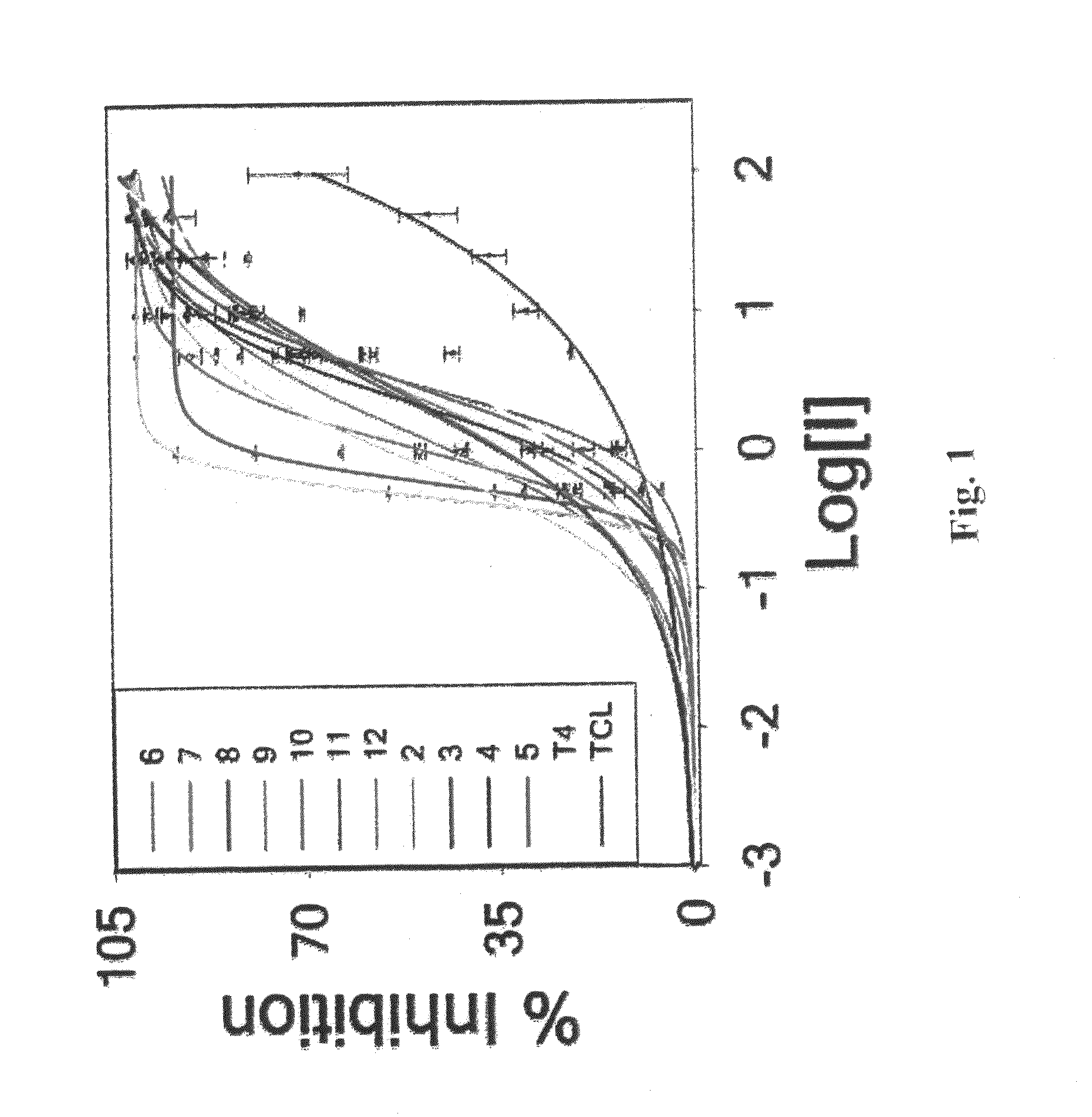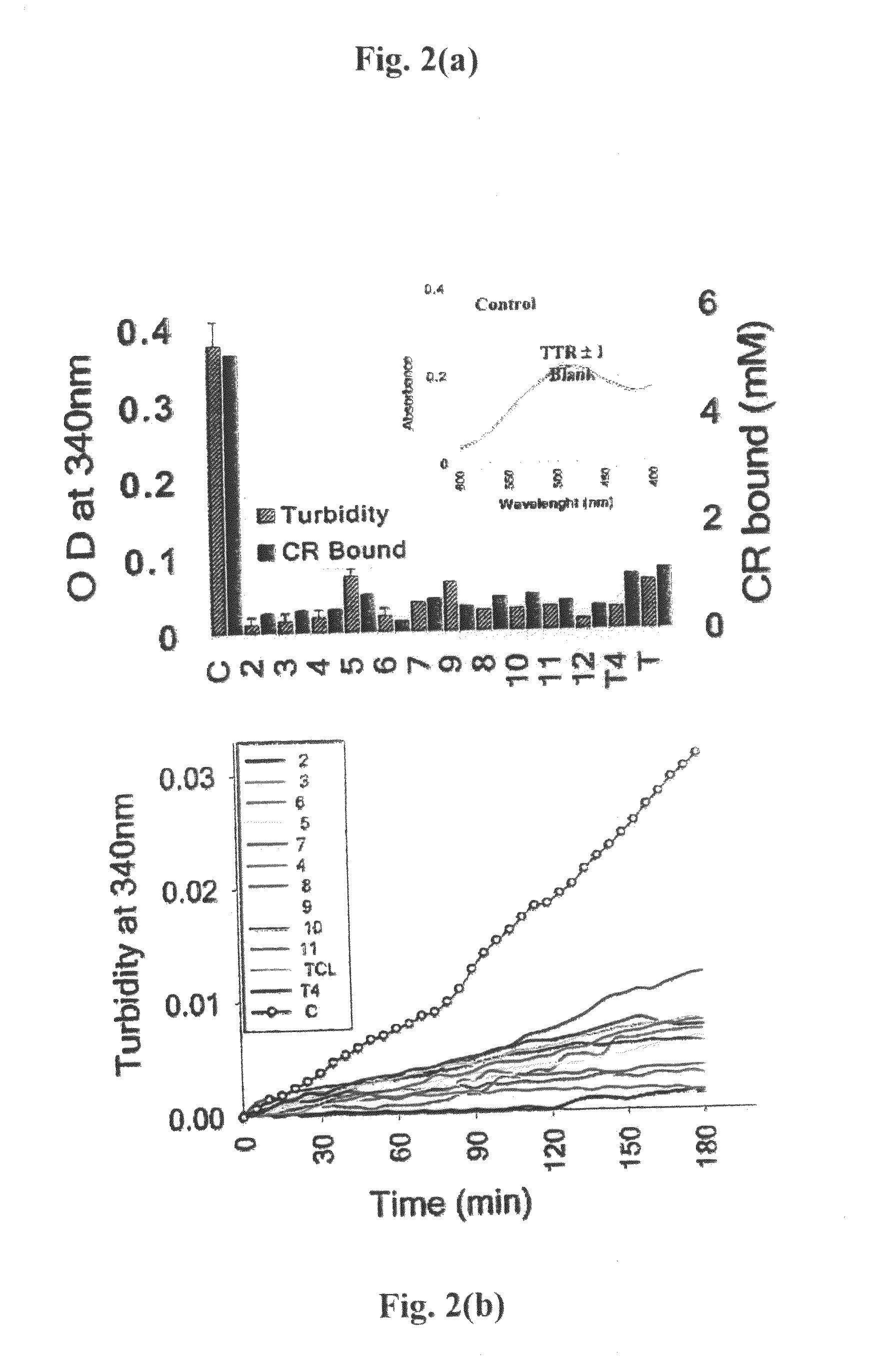Mechanism-based inhibitors of transthyretin amyloidosis: studies with biphenyl ethers and structural templates
a technology of thyretin amyloidosis and inhibitors, which is applied in the field of mechano-based inhibitors of transthyretin amyloidosis, can solve the problems of limited success of ttr amyloidosis inhibitors including both natural and synthetic molecules that span a variety of structural classes, and most of these diseases are incurable and fatal
- Summary
- Abstract
- Description
- Claims
- Application Information
AI Technical Summary
Benefits of technology
Problems solved by technology
Method used
Image
Examples
example 1
[0117]Stagnant Acid-Mediated TTR Aggregation Assay. The efficacy of compounds 1-12 was determined by stagnant acid-mediated turbidity assay at 340 nm using Tecan GENios microplate reader.
[0118]For stagnant aggregation assays a series of eppendorf tubes containing 7.2 μM tetramer (0.4 mg / ml) of TTR in 5 mM sodium phosphate, 100 mM KCl, 1 mM EDTA, pH 7 were incubated with inhibitor 7.2 (1:1) and 21.6 μM (1:3) (DMSO 1%) in 0.5 ml at 25° C. After 1 h, the samples were diluted with 0.5 ml of 200 mM sodium acetate buffer containing 100 mM KCl and 1 mM EDTA. Samples after mild vortexing were incubated at 37° C. for the desired amount of time without stirring to evaluate the efficacy of the inhibitors. The extent of aggregation was probed by turbidity measurements at 340 nm using Tecan GENios microplate reader. Single time point samples in eppendorfs (72 h) were vortexed for 5 sec immediately before the measurement to quantify fibril formation. The extent of TTR fibril formation in the abse...
example 2
[0125]Time Course of Fibril Formation. The kinetics of inhibition was studied by incubating 7.2 pM TTR with 21.6 pM of different inhibitors in 100 pl of 5 mM phosphate buffer pH 7.2 for 30 min in a 96 microwell plate. After 30 mM 100 wl of 0.2 M sodium acetate buffer pH 4.4 containing 1 mM EDTA and 100 mM KCl was added. The difference in turbidity was assessed by measuring the change in absorbance at 340 nm on Tecan GEnios microplate reader using Magellan software. For kinetics, parameters were set for 30 cycles at 37° C. at the interval of 5 min each and 2 min orbital shaking (low speed) between cycles and 10 sec shaking (normal speed) before measurement. All experiments were performed in triplicates. Change in absorbance at 340 nm was plotted against time in the presence and absence of inhibitors initial rate of fibril formation was calculated from the slope by linear fitting of the data.
[0126]All experiments were performed three times in triplicates. Change in absorbance (mean of...
example 3
[0127]Congo Red Binding. The amount of bound Congo red was estimated as reported earlier Lashuel, H. A., Wurth C. Woo, L., Kelly, J. W. The most pathogenic transthyretin variant, LS5P, forms amyloid fibrils under acidic conditions and protofilaments under physiological conditions. Biochemistry 1999, 38 (41), 13560-135 revised 73 using the equation, moles of Congo red bound / L of amyloid suspension=A540(nm) / 25295−A477(nm) / 46306.
PUM
| Property | Measurement | Unit |
|---|---|---|
| Elongation | aaaaa | aaaaa |
| Temperature | aaaaa | aaaaa |
| Fraction | aaaaa | aaaaa |
Abstract
Description
Claims
Application Information
 Login to View More
Login to View More - R&D
- Intellectual Property
- Life Sciences
- Materials
- Tech Scout
- Unparalleled Data Quality
- Higher Quality Content
- 60% Fewer Hallucinations
Browse by: Latest US Patents, China's latest patents, Technical Efficacy Thesaurus, Application Domain, Technology Topic, Popular Technical Reports.
© 2025 PatSnap. All rights reserved.Legal|Privacy policy|Modern Slavery Act Transparency Statement|Sitemap|About US| Contact US: help@patsnap.com



